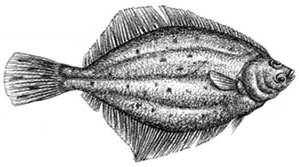Appearance

Scientific Name
Paralichthys dentatus
Market Forms
Whole, dressed; filets, fresh, frozen; a large array of value-added forms including stuffed and breaded. Size
Commercial average landed size is 2 to 5 pounds and 18 to 24 inches. Taste/Texture
Any wonder that flounder is so highly prized with its lean, white meat and light, delicate flavor. Its firm texture allows great flexibility of preparation from broiling and frying, to stuffing and poaching. Seasonality
Flounder are available year round. Nutritional Value
86 Calories (100 grams, 3.5 oz.)
18.8% Protein
1.2% Fat
.2% Omega-3 Substitutability
Flounder can be substituted for Dover sole, orange roughy, pompano or snapper. Folklore
The old adage “flat as a flounder”should more properly be “flat as a mature flounder,”because these “flatfish”as they are called, are born swimming in a vertical position, but undergo a bizarre metamorphosis as they mature. One eye moves across the top of the head until it rests close beside the other, the head becomes twisted and the mouth is adjusted toward one side. It also adjusts its color to blend with its environment, thereby preparing for its life lying on or swimming near the bottom. Harvesting
Large mature fish are harvested in deep waters by offshore trawlers. In the Chesapeake Bay and its tributaries, it is harvested in pound nets by day boats. Safety/Quality
Virginia’s waters and products are regulated by federal and state agencies including the FDA, the Virginia Department of Health, the Virginia Department of Agriculture and Consumer Services, the Virginia Department of Environmental Quality, and the Virginia Marine Resources Commission, insuring that only safe wholesome seafood reaches our customers.

